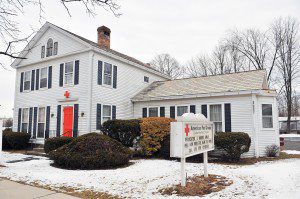WESTFIELD – While funding has been secured for Domus Incorporated to turn the old Red Cross building on Broad Street into a house for homeless teens living in the city, questions have been raised by local officials and others in the community regarding the necessity and validity of the project.
The facility, to be called “Our House”, is set to house ten teen residents and a resident manager who will oversee and supervise the young adults who will be occupying the home.
“Homelessness is the major criteria, but they (the teens) have to want to finish high school,” said Domus Executive Director Ann Lentini. “They will come to us with a sponsor who will guide them, because we don’t want any lapses in guidance.”
Lentini said that sponsors could be teachers in school or parents of other students.
“We will screen all potential sponsors, and so much of this is going through the guidance department at Westfield High School. We’ll be keeping in touch with sponsors and other mentors all the time,” she said. “We’ll have a resident manager who will live there and oversee everything and make sure residents follow the rules.”
According to Lentini, the tenants of the home will each be responsible for tasks that will help prepare them for life after Our House.
“There is a weekly schedule that is in the works, and students will take turns purchasing and cooking food,” she said. “We don’t want them just hibernating in their rooms. We want them to be responsible.”
“They have to attend classes and earn passing grades while also evaluating their next step,” she said. “Are they going to Westfield State, Holyoke Community College, or getting a job? And we’ll help them with that.”
A garden will be located in the backyard, as well, for the students to maintain.
“There’s nothing more gratifying than to see tomatoes and cucumbers that you tended to, bloom,” she said. “These are students whose lives have been short-circuited, and we want them to get back on track.”
Lentini and Westfield Superintendent Dr. Suzanne Scallion have in the past both addressed the issue of homelessness in the district’s student population, estimating around 30 students struggle with homelessness at WHS alone. So what becomes of the remaining 20 students who do not find residence at the facility?
“Some of those students are moving on (from the high school),” Lentini said, in regards to the small size of the new facility. “Someone said ‘why don’t you have a house for 30 kids?’ Well, a house like that is not easy to maintain. Ten students is a lot.”
Regarding criticism of certain members of the Westfield City Council aimed at the project, Lentini had plenty to say.
“I feel that that’s a shame for some to not think of the value of this,” she said. “Aside from a facility in Deerfield and a temporary facility in Springfield, this is the first of its kind in western Massachusetts. This is permanent housing to get these students back on their feet.”
“Many on the city council are behind this, and the state is, too. We’ve been granted $80,000 in funding through the Community Preservation Act, which is designated for historical buildings, affordable housing, and public projects like playgrounds,” Lentini said. “We know this will be successful.”
According to Lentini, the project is slated to cost approximately $1.44 million, to be paid for not only by the CPA grant but also through state bonds and trust funds which have been set up for projects of this nature.
“These aren’t tax dollars. They’re bonded funds, and if we didn’t get them, some other cities would have,” said Lentini. “The Department of Housing and Community Development really liked the project.”
“Clearly it means taking care of our most at-risk students, and it will give them the stability they need,” said Westfield High School Principal Jonathan Carter.
Carter, who also served as principal of two high schools in Springfield, as well as Holyoke’s William J. Dean Technical High School, is no stranger to the harsh reality of student homelessness.
“When I was at Dean, they (students) did struggle with it. Out of 400 students, I had between 80 to 100 that were homeless. But it’s always a struggle to find funding,” he said. “Working with outside agents, families, and healthcare providers, it takes a group effort to help students overcome these hardships so they can focus on school.”
“In my eyes, education is the one constant that can provide a way out for young people, so they can provide and take care of their families,” he said. “Education is the one thing that, even if you have nothing, no one can take from you. You may not have a car, a home or a family, but if you have an education, no one can take that away.”


